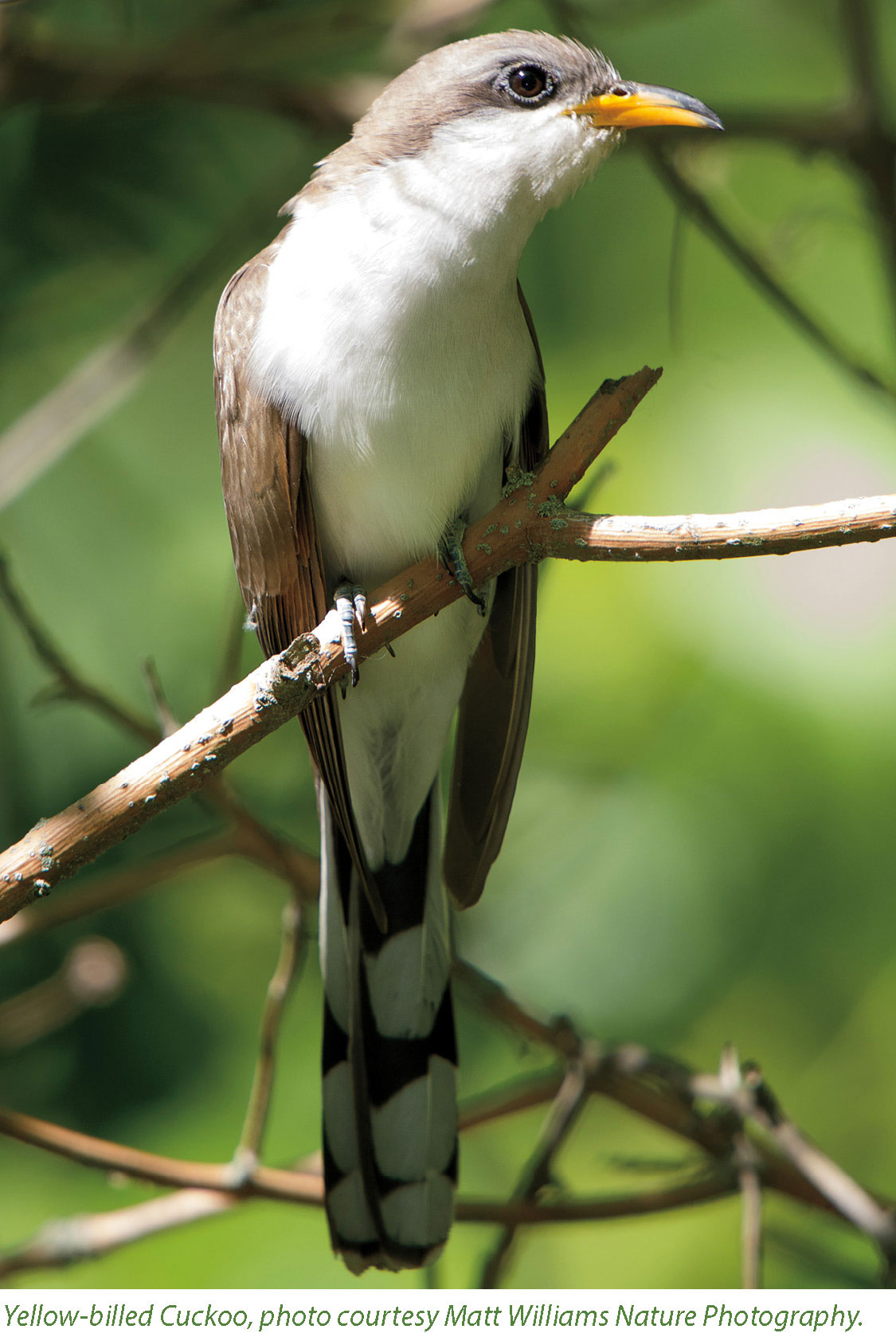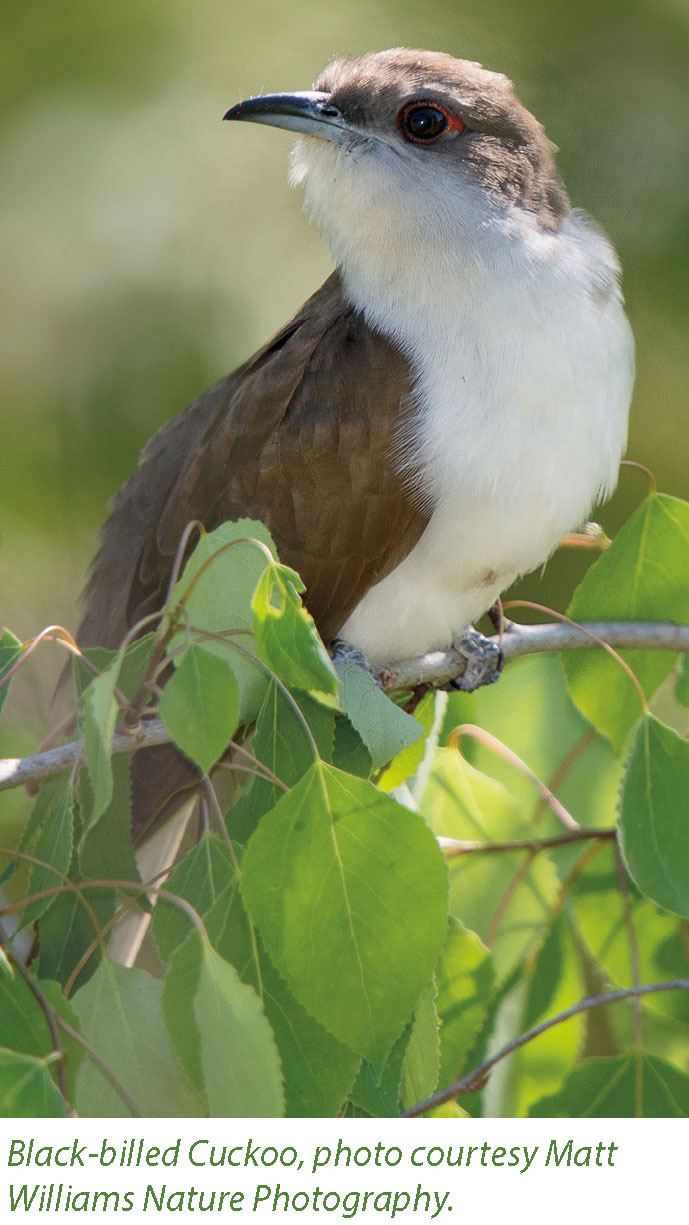The Birders’ Dozen Profile 8: Yellow-billed Cuckoo
Welcome to the Birders’ Dozen! Over the next five issues we are going to continue introducing the last half of the bird species from Forestry for the Birds. The Birders’ Dozen are forest birds that can benefit from targeted management practices, as most are declining due to habitat loss. We’ve curated this list to cover a wide range of habitat types, from young to mature forest, open to closed canopy, or dense to non-existent shrub layers. Our goal is to engage landowners and foresters in the process of managing forests for wildlife, or “forests for the birds.”
Skulking in riparian shrubs and singing on dreary days, the “Raincrow” or Yellow-billed Cuckoo is a unique bird in need of proactive management. Though this species has been declining most significantly in the western portion of its range due to loss of habitats near rivers, cuckoos in the east have lost approximately 60% of their population in the past 50 years. The Black-billed Cuckoo, a closely related species, has also been declining significantly; both species occupy similar niches, though the Yellow-billed Cuckoo is slightly more widespread and will be the primary focus of this profile.
Natural History
Cuckoos are often called “Raincrows” because of a penchant for singing in the rain or on cloudy days, as well as their skulking, secretive behavior when foraging or when observers are near. They are primarily insectivorous, though they also consume berries and occasionally amphibians and small reptiles. Their foraging habitat, then, is often riparian shrub and open woodlands near water. Cuckoos nest in dense deciduous areas, often near the ground. Though they are often found near rivers, eastern populations of cuckoos are not restricted solely to these areas and may nest in hardwood groves with consistent humidity.
A migratory species that spends the winter in South America, the cuckoo has one of the more unusual breeding systems in the bird world. Cuckoos are brood parasites, which means they lay eggs in other birds’ nests and trick the host parent into raising their young. However, they only do this occasionally and most often to other cuckoo nests. For this reason, they are known as “facultative” brood parasites, unlike “obligate” brood parasites such as the Brown-headed Cowbird which only lay eggs in the nests of other bird species. It is possible this behavior is a response to times of increased food abundance, such as periodical cicada outbreaks. In fact, many of the cuckoo’s favorite food sources are insects that outbreak periodically, like eastern tent caterpillars and fall webworms, gypsy moth larvae, and cicadas.
When cuckoos exhibit typical breeding behavior, they are generally monogamous pairs, both parents helping to build the nest. Nests are built from twigs and leaves in trees or large shrubs, typically in areas with dense foliage and shrub cover and often near humid or wet areas. The female lays a clutch of 1-5 blue-green eggs, the number likely dependent on food availability as mentioned above, and incubates them around 10 days. Hatchlings, which are fed mostly caterpillars, are feathered within hours of hatching and fledge very rapidly, within 7-8 days.
Habitat Management
Though considered a shrubland species by many, Yellow-billed Cuckoos are dependent on areas of woodland and young forest. Management for both species of cuckoo should include both forest management to create nesting and foraging habitats as well as creation of openings and shrubby areas for foraging, particularly if nearby riparian zones are available and can be restored.
Cuckoos can use a wide range of habitat types, from abandoned farmland and orchards to thickets along creeks to regenerating clearcuts. They often use areas with dense stands of young saplings, both for foraging and for nesting. While most research on Yellow-billed Cuckoos is focused on western populations as these populations are declining fastest, some recommendations can be applied to Midwestern forests as well.
Provision of open areas with dense shrub layers is the most important aspect of management to create cuckoo habitat. When forests are near waterways, management to create openings can greatly benefit cuckoos, both in encouraging insect populations to grow and providing nesting site shelter from predators. Removal of invasive shrubs and providing native berry-producing plants like blackberries, elderberries, and wild grape can also benefit cuckoos, especially during migratory seasons.
Finally, cuckoos are dependent on insects for food. Broad spectrum pesticides such as neonicotinoids (e.g., imidacloprid) can be fatal to insects that might not be considered true pests, including important pollinators like bees. Pesticides can also harm cuckoos themselves, when cuckoos eat insects contaminated with chemicals. Limiting use of pesticides, especially in areas near waterways where many insects breed, can thus be beneficial for cuckoos as well as benefitting local pollinators.
Conclusion
These two striking birds, the Black-billed Cuckoo with its bright red eye ring and the Yellow-billed Cuckoo with its domino tail spots, are important insect predators in young Midwestern forests. Management that focuses on providing open shrubby areas, especially near waterways, can provide important habitat for these secretive Raincrows. Like some of the other birds we’ve discussed in these profiles so far, management for young forest is often overlooked but is still an important aspect of maintaining a diverse and healthy forest ecosystem in Indiana.
Special thanks to the Alcoa Foundation, the Indiana Forestry Educational Foundation, and The Nature Conservancy for their support and leadership of Forestry for the Birds.
Jessica Outcalt is an independent consulting biologist who worked with The Nature Conservancy to develop the “Birders’ Dozen Profiles.” She is now an Agriculture and Natural Resources educator with Purdue Extension in Grant County. She completed her BS in biology at Taylor University, her PhD in wildlife ecology at Purdue University, and is passionate about birds and getting people involved in conservation and scientific processes.
References
Hughes, J. M. (2020). Yellow-billed Cuckoo (Coccyzus americanus), version 1.0. In Birds of the World (P. G. Rodewald, Editor). Cornell Lab of Ornithology, Ithaca, NY, USA. https://doi.org/10.2173/bow.yebcuc.01
Reiley, Bryan M., and Thomas J. Benson. 2019. “Differential Effects of Landscape Composition and Patch Size on Avian Habitat Use of Restored Fields in Agriculturally Fragmented Landscapes.” Agriculture, Ecosystems & Environment 274 (March): 41–51. https://doi.org/10.1016/j.agee.2018.12.017.
